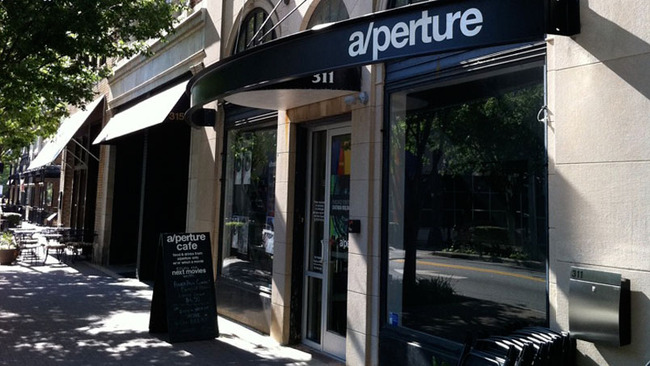Watching Winston-Salem

At a time when many talk of cinephilia as going the way of the woolly mammoth, it’s more than a little inspiring to come upon a place like the Aperture Cinema in Winston-Salem, North Carolina. This two-screen art-house theater (which we’ve mentioned here on the Current a couple of times in our weekly Repertory Roundups), situated on a main drag of the city’s downtown, opened only fifteen months ago, in January 2010. Its founding was both an act of defiance against film culture’s movement toward new ways of viewing and a labor of love by its married owners, Lawren and Jigar Desai, undertaken to fill what they perceived as an enormous gap in this otherwise thriving arts community. With its approachable, neighborhood feel, the Aperture brings art-house and independent contemporary cinema to college students and locals alike.
When I was in Winston-Salem last week serving on a jury for its annual RiverRun International Film Festival—an invigorating, beautifully run program gathering a hearty selection of the best in recent cinema from around the world—I met with Lawren Desai to talk about the challenges and joys of opening an art-house theater. “I don’t want this to die,” Desai said of the theatrical experience, as she showed me the theater’s two eighty-seat screening rooms, each with 35 mm, digital, and digibeta projection capability. Desai, a Winston-Salem native and former business major who hails from a family of movie lovers (“For years, my family would sit around talking about the dearth of art-house cinema in town”), compares moviegoing now to the perpetuation of vinyl records—as a somewhat outmoded but purer, more direct engagement with the art at hand.
The Aperture, which has had a successful first year, was conceived of as a shot in the arm for a film community that used to lie dormant most of the year, awakened only when RiverRun came around. There hadn’t been an art-house cinema downtown for almost thirty years, and Desai recalled having to drive far out of town to see non-multiplex fare for most of her childhood. One of the Desais’ important collaborators on the project was the festival’s executive director, Andrew Rogers, who agreed with them that a venue like Aperture would be a way to bring festival movies to Winston-Salem all year long. Sometimes, this mission becomes literal, when the Aperture books films that were popular at RiverRun to give locals another chance to see them (recent successes of this kind include Jean-Michel Basquiat: The Radiant Child and I Am Love). The theater also shows contemporary international cinema (White Material, The Illusionist), does a summer animation series for families, and hosts a “CineClub” the second Monday of every month, for which off-the-beaten-path titles are screened for more adventurous filmgoers. (And you can still see remnants of the Halloween weekend screening of House—I saw the Japanese cult sensation’s iconic gaping feline maw stuck not only to the Aperture’s cash register but also to the window of an unoccupied storefront kitty-corner from the theater.)
The more I learned about Winston-Salem, the more surprising the fact that it had been without an art house for so long became. The city, known more for its intimidating legacy of industry (R.J. Reynolds tobacco, HanesBrands underwear, Krispy Kreme doughnuts, and the Branch Banking & Trust corporation), is also a vibrant arts center, presided over by the University of North Carolina School of the Arts. Filmmaker Peter Bogdanovich recently joined the faculty there, and I was lucky enough to be present for his ecstatic introduction at RiverRun of a lustrous 35 mm print of one of his favorite movies, Jean Renoir’s French Cancan.(He exclaimed that the film’s “climax is the most joyous sequence ever put onscreen,” and regaled the appreciative crowd with anecdotes about the great humanist filmmaker, whom he knew personally.)
The jewel in the Winston-Salem film community’s crown, though, has to be UNCSA’s immense Moving Image Archives, the fifth largest noncommercial archive of film prints in the country (behind only such heavy hitters as the Library of Congress, UCLA, the George Eastman House, and the Museum of Modern Art). I got a tour of the overwhelming celluloid treasure trove from associate curator Matt Jones, who informed me that the vast aisles contain not only three thousand Technicolor three-strip prints, an impressive cache of 70 mm titles, and films from the likes of Buñuel, Hitchcock, Malle, and Cassavetes but also one of the world’s largest collections of B movies and exploitation pictures.
The Moving Image Archives undoubtedly cements Winston-Salem’s standing as a bastion of cinephilia. Its endless rows of heavy film canisters, reminders of a time before films could exist on hard drives, have pride of place in the community. Clearly, the Aperture cinema, with its commitment to traditional moviegoing, fits right in. In fact, Desai said, she prefers to think of her small theater as a kind of repository as well, “a museum in which we’re trying to preserve the film experience.”




